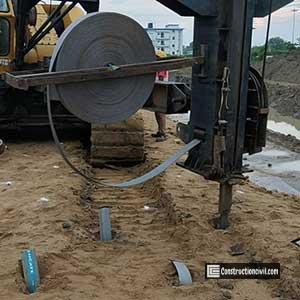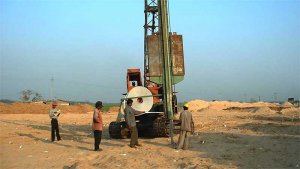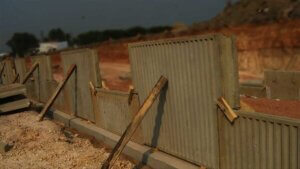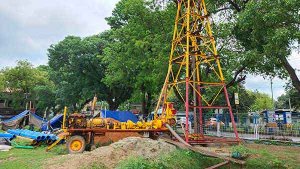PVD Drain, known as Prefabricated Vertical Drains, has a channelled plastic core covered with a geotextile like a jacket. The channelled plastic core supports the wrapped filter fabric and delivers longitudinal flow paths through the drain length. The plastic core also provides resistance to stretching as well as buckling of the PVD. It acts as a filter to limit the passage of fine-grained soil into the core and also prevents the closure of the internal water flow paths under lateral soil pressure.
Equipment & Materials Required for PVD Drain :
The General List of Equipment and Machinery Required for the Installation of PVD:
- Mechanical Crane
- Excavator/Backhoe Loader
- Roller/Compactor
- Dumpers
- Minitruck/TMC
- Trailers -40 Ton
The General List of Materials Required for the Installation of PVD is Listed Below:
- AD 250 Prefabricated Vertical drain
- Sand
- Tools and tackles for installation purposes
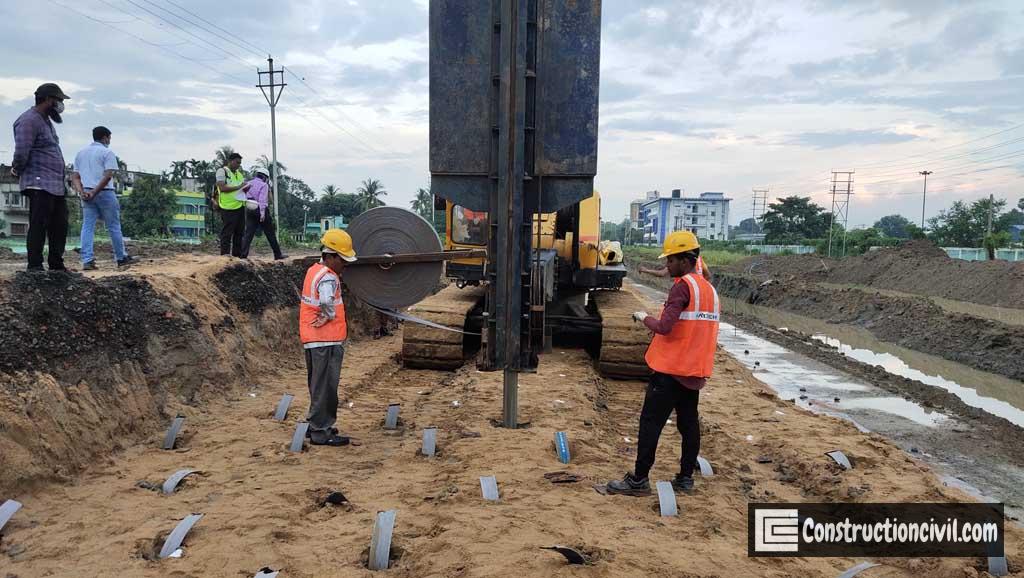
Also, Read: Top 7 Ground Improvement Techniques in Civil Engineering
Preliminary Activities for PVD Drain Construction:
- Before any construction activities related to PVD installation, pre-construction evaluations should be completed to determine existing conditions that could affect the construction.
- Based on the evaluation studies wherever applicable (Ground stabilisation if required, traffic management, road closures etc., as per the traffic management plan), the pre-construction activities shall be taken up and completed before starting driving of PVD.
General Sequence of PVD Drain Construction:
1. Area Development (C&G)
2. Marking of Plan as per approved drawings (survey)
3. Excavation till Required Level
4. Working Platform Development (Using sand fling) 5. Individual Drain position marking (Setting out points)
6. PVD installation
Stage-wise Construction Techniques:
Area Development (C&G):
Prior to starting PVD Drain works, area development is to be done.
SURVEY – Marking of Plan as per Approved Drawings:
- Before PVD Drain installation, all corners, as per the plan view, are to be marked.
- Before marking points, it will be ensured that the area should be dressed and cleared so that it can receive survey points that remain unerased until work completion.
Excavation:
- Excavation of marked area will be executed with the help of an Excavator/backhoe loader as applicable.
- Proper care will be taken for an excavated ramp with adequate shoring if required.
Working Platform Development:
- A working platform will be prepared to the lines and levels specified in the construction drawings.
- The working platform must be made with sufficient bearing capacity (generally a sand fill platform) for the Equipment movement.
- Sand is filled by 200 mm to 300mm, as shown in the working Drawing.
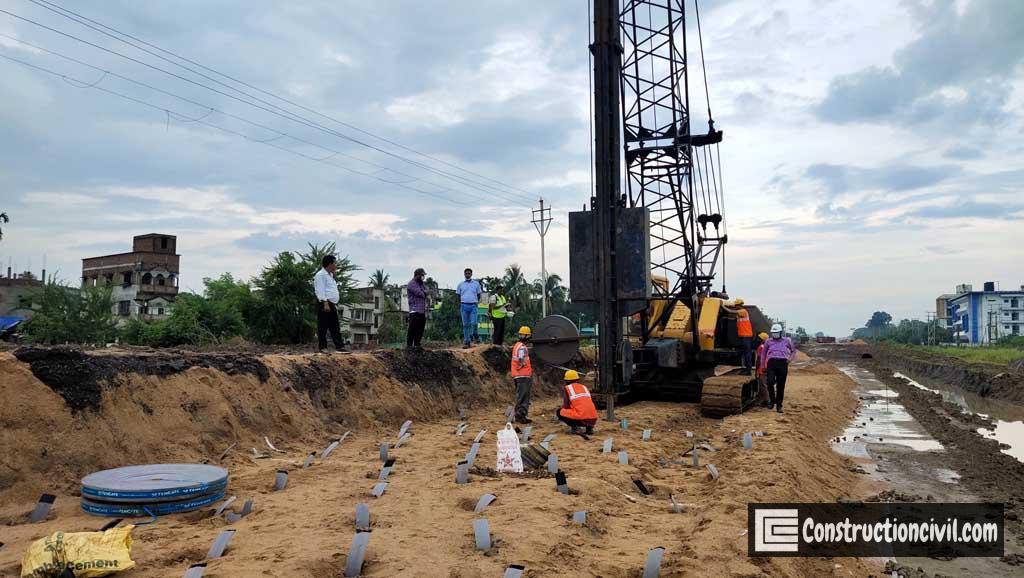
Also, Read: Ground Improvement Techniques – Vertical Drain & Stone Column
Individual Drain Marking and PVD Drain Installation:
- Individual drain position to be marked as per the drawings before starting Installation work.
- The PVD Drain shall be located, numbered, and staked as per standard international practices.
- The as-installed location of the PVDs shall not vary by more than 200 mm from the plan locations designated on the drawings.
- PVD Drains shall be installed from the working surface to the depth as shown on the drawings or as directed by the Engineer.
- Drains can be terminated if the refusal is encountered at a depth less than 80 % of the design calculated depth. The refusal length of each prefabricated drain may vary based on the geological formations encountered over the site. The refusal shall be defined as the installation of the drain to the non-compressible layer underlying the compressible layer to be consolidated.
- Prefabricated Vertical Drains(PVD) installation equipment will indicate refusal depth when the tip of the mandrel meets some resistance and stops or slows at the approximate depth of the non-compressible soil layer.
- During installation operation, the Contractor shall provide the Engineer with suitable means of deciding the depth of the advancing drain at any given point of time and the length of the drain installed at each location.
- The draining material shall be cut neatly at its upper end with 200 mm to 300 mm (8 to 12 Inches) protruding above the working surface.
- If the PVD Drain is to connect to the prefabricated horizontal drainage, sufficient PVD material shall be left to make the connection properly.
Also, Read: Geotechnical Investigation Objectives and Guidelines
Connection of PVD to Anchor plate and Anchor Rod:
A length of a minimum of 150 mm of PVD is pulled out from the mandrel, wrapped around the fixture of the anchor plate or Anchor Rod and folded back tightly. Due to the stiffness of the Prefabricated Vertical Drain, then the folded part secures itself to the steel anchor plate. After that, the drain is pulled back into the mandrel until the plate/rod rests against the mandrel.
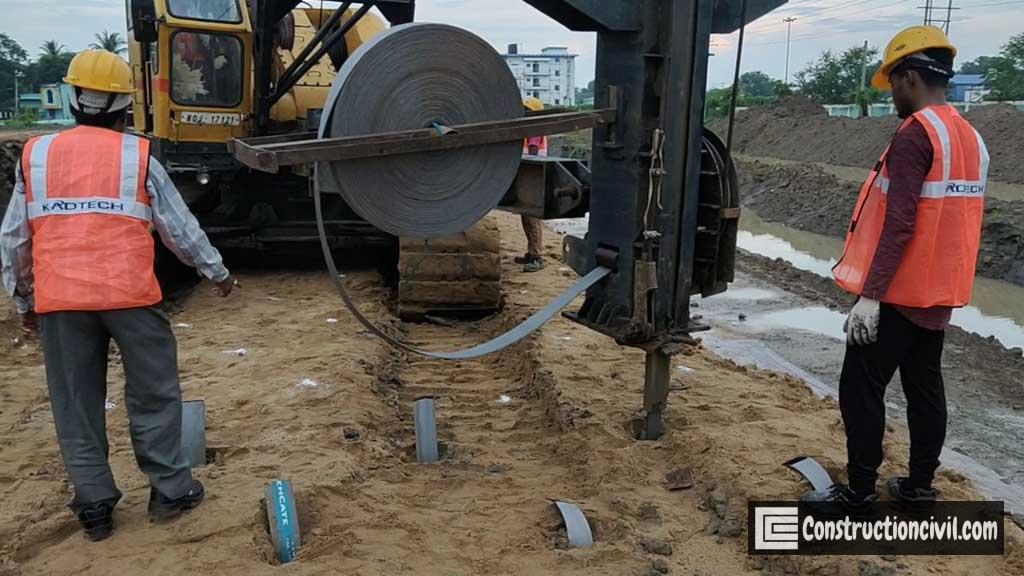
Also, Read: Soil Reinforcement Methods – Advantages and limitations
Splicing of PVD Drain Material:
Splicing of the PVD drain material shall be done by stapling in a workmanlike manner to ensure structural and hydraulic continuity of the drain. At the splice, the jacket that passes through the installation rig first shall be external to the trailing portion. A maximum of one splice per drain will be permitted without specific permission from the Engineer. The jacket and core shall be overlapped a minimum of 300 mm (12 inches) at any splice.
Theoretical Considerations:
- Determination of drain spacing for the required degree of consolidation in a particular period of time (i.e. Waiting Period) for Prefabricated Vertical Drains(PVD).
- Settlement analysis based on the three-dimensional consolidation process
- Consideration of the smearing effect during the analysis.
- Required Drainage parameters – Coefficient of consolidation of both horizontal and vertical direction of soft foundation soil in addition to the vertical drain characteristics (discharge capacity).
The most suitable soil conditions/types for preloading with or without vertical drains are consolidated soft clays, silts, organic deposits, and completed sanitary landfills. Materials required for the above types of ground improvement are earth fill or other material for loading the site and sand, gravel or geotextile for drainage blanket. Preloading can be used along with vertical drains to reduce consolidation time.
There are three types of preloading which are simple preloading, surcharge preloading and stage loading. For surcharge preloading, a temporary fill is applied to the permanent fill so that the anticipated settlement under the permanent fill alone can be achieved in less time. The temporary surcharge should be removed after 90% of the anticipated settlement is achieved, and no excess pore water pressure is left in the soil. In practice, the time for surcharge removal was determined based on the construction schedule, and the height of the extra surcharge could be calculated.

Also, Read: Vibroflotation, Blasting & Dynamic Compaction – Ground Improvement
Health & Safety Precautions:
- Work shall be executed under competent and continuous supervision.
- All equipment movement shall be monitored with proper signalling/ warning systems.
- All material handling tools & tackles shall be properly tested as per the EHS plan.
- Any unauthorised activity shall be strictly prohibited
- There should be good coordination and communication between teams/workers at times.
- Proper housekeeping shall be maintained.
- Required inspections shall be carried out prior to starting work.
- Proper illuminations shall be maintained during night work.
Also, Read: SPT Test for Soil Procedure, Refusal Conditions & Correction
